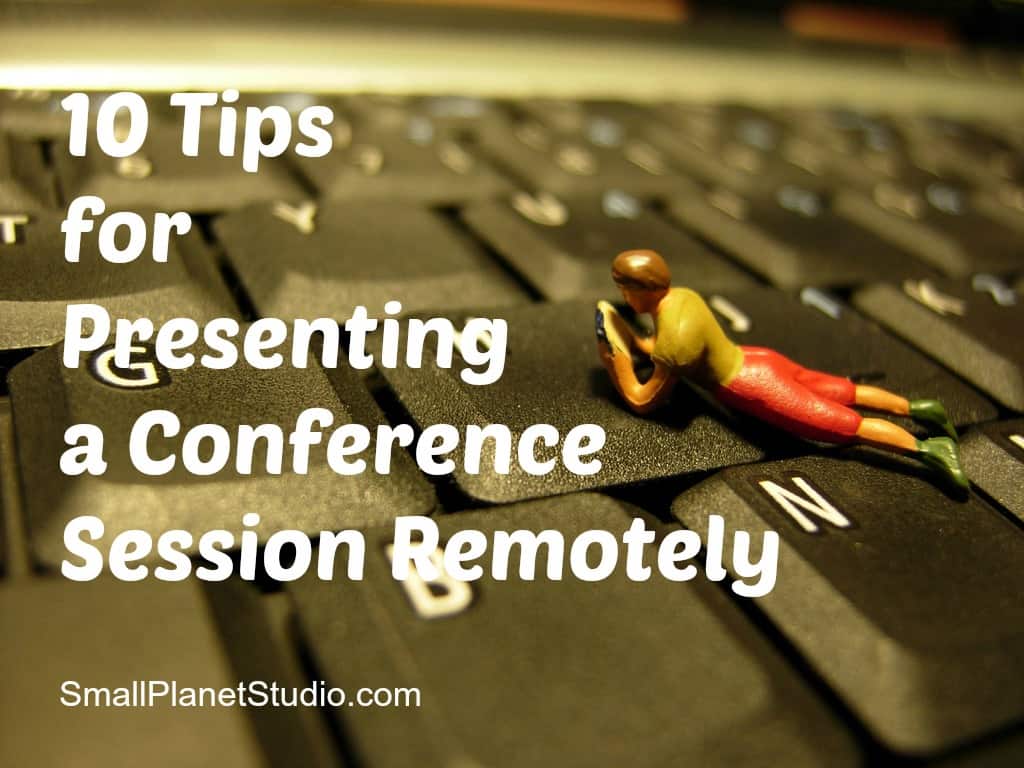10 Tips for Presenting a Conference Session Remotely
What would you do if you were invited to present at a major conference in your field that you knew you couldn’t attend?
Would you decline the invitation?
Send a colleague to delver your presentation?
Or web conference in for your part?
Since I chose the third option for the recent NAFSA conference, I thought I’d share some tips. Our session went very well, in part because we followed these tips (some of them I learned the hard way in previous presentations), and in part because I had two wonderful co-presenters.
I’d love to hear your tips – feel free to share them in the comments!

Tip #1: Confirm with the conference organizers. Find out what kind of technology is available, what’s offered for free, and what you have to pay for. Internet access is typically available these days but it’s not always offered to presenters without a fee.
Tip #2: Choose the right technology for the job. After we decided on the content and flow of our session, we discussed how we’d work the technology. Jennifer and Sandy, my co-presenters, delivered their presentations in person, and originally we thought I’d Skype in for my part. But when I realized that I wouldn’t be able to show my Prezi, we switched to AnyMeeting, which is a web conferencing platform I’ve been using for webinars. Choose a platform that does what you need it to do but keep things as simple as possible so there’s less that can go wrong.
Tip #3: Have a plan B. And a plan C. Maybe even a plan D. We had two back-up plans in case we had problems with AnyMeeting. Plan B was Jennifer clicking through my Prezi for me while I delivered my presentation via Skype. In the event of major internet issues, plan C called for Jennifer playing the pre-recorded webcast of my presentation. Fortunately, our plan A worked great!
Tip #4: Don’t forget adapters and cables. The one thing I don’t like about my Mac is that I have to remember to bring an adapter in order to connect to a projector. Write yourself a note, set an alarm on your phone, have your significant other call and remind you — do whatever you need to do in order to remember all computer paraphernalia you’ll need. There’s nothing worse than realizing that you can’t project that Prezi you worked so hard on!
Tip #5: Use an Ethernet connection. Don’t use a wireless internet connection. You never know how strong the wireless connection will be, and I’ve even had problems simply connecting to a new wireless network. It’s best if both laptops use a wired connection, especially if you want to share your desktop or broadcast video.
Tip #6: Arrive early to set up and test. Jennifer and I started setting up 30 minutes before the presentation started. We had more time than we’d initially planned because our session was right after lunch and nobody was in the room.
Allow yourself more time than you think you need. You never know if you’ll need a different Ethernet cable, will have to download something, or re-start your computer (I’ve experienced all of those things). We were set up and ready to go with 10 minutes to spare, but I’d rather have 10 minutes to kill than start late due to an unforeseen technical problem.
Tip #7: Know how to contact tech support. Conferences usually provide tech support at the beginning of sessions, and NAFSA had someone there with Jennifer before our session, but it’s always a good idea double check with conference organizers who you should contact in the event of a tech emergency. I’ve had tech issues crop up at the last minute, even after testing everything in advance, and tech support has been helpful in quickly solving the problems.
Tip #8: Find a quiet place. I know this is pretty obvious, but it’s easy to forget about alarms, loud trucks driving down the street, knocks on doors, and cats who decide they need to sit in your lap now. If I’m broadcasting from my university office I usually put a note on my door.
Tip #9: If you broadcast video, place your laptop on a small stack of books. Doing so will enable you to look directly into the webcam instead of looking down at it.
Tip #10: Record your session. At the minimum you’ll have a record of your session, and at best you could have a webinar to share with people who couldn’t attend your session. We didn’t think the sound would work well enough in our session so I didn’t record, but I should have done it anyway because everything worked better than expected.
What are your tips? I’d love to hear them!
